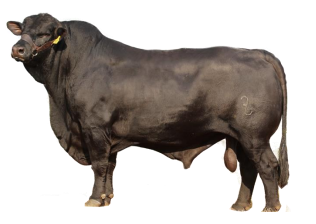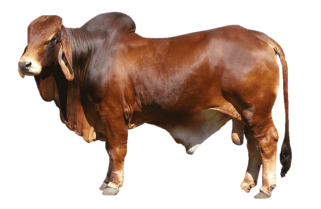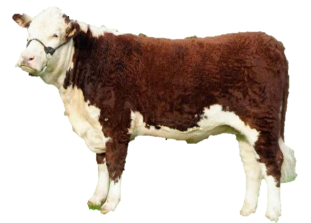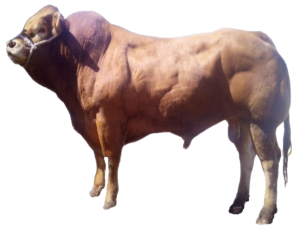Ruminant Production: Beef Cattle Production
1/56
There's no tags or description
Looks like no tags are added yet.
Name | Mastery | Learn | Test | Matching | Spaced |
|---|
No study sessions yet.
57 Terms
Backgrounder Operation
referred to as a ‘stocker’ or ‘grower’operation) A type of beef cattle rearing operation in which weaned younger/lighter weight steer calves and weaned heifer calves that are not being kept as future breeding cows are raised to about 12 to 16 months of age while grazing on inexpensive feed sources such as grass or other forages. Animals develop lean muscle mass and increased body frame/size prior to entering a feedlot while on these operations
BULL
An intact, sexually mature male bovine that is intended for breeding purposes
BEEF CATTLE
Cattle that are intended for meat production
CALF
A young bovine, either male or female, up to one year of age
CATTLE FED IN CONFINEMENT FOR SLAUGHTER
It refers to beef and dairy breed cattle that are confined in group pens and fed a high-energy diet until the time of slaughter
COW-CALF OPERATION
A type of beef cattle operation with the purpose to produce calves that will become either future breeding cows or breeding bulls, or calves that will be raised for meat production. The goal of a cow-calf operation is to have each cow produce and raise one calf per year
Culling
Removal of an animal from a herd usually for health or production reasons`
Fed Cattle
Steers and heifers that have been fed concentrates while on a feedlot.
FEEDERS
Weaned calves grazing pasture that have reached sufficient weight and maturity to go to a feedlot to be placed on a high energy ration for finishing; they are generally older, weigh more, and carry more condition (finish) than stocker cattle (‘stockers’)
FEEDLOT (OR FINISHING) OPERATION
A confinement production operation in which beef cattle are raised to market (slaughter) weight while being fed high concentrate diets on a feedlot (‘feedyard’)
Finishing Phase
The period of time that cattle are on a feedlot is referred to as the
FINISHING PERIOD
The final feeding stage of cattle on a feedlot prior to animals reaching market weight
FIRST-CALF HEIFER
After giving birth to its first calf, a replacement beef heifer may be referred to as a
GRASS-FED/GRASS-FINISHED BEEF
Beef that comes from cattle that have been raised primarily on pasture forages; also refers to cattle that are fed pasture forage as opposed to cattle that are raised on a feedlot being fed high concentrate diets
HEIFER
A female bovine from the time of weaning until the time of first calving
LACTATING BEEF
refers to lactating beef breed female cattle that are nursing calves intended for meat production. Milk from lactating beef cows is NOT intended for human consumption
NON-LACTATING BEEF COWS
Female beef cattle that had previously nursed calves, but which are NOT currently producing milk
18-22 Months, 1200 to 1400 pounds 545 to 637 kg
Market Age and Weight
PRE-RUMINANT
An animal with a rumen that is not yet anatomically or functionally mature
PUREBRED CATTLE
Cattle whose ancestors over many generations are derived from a recognized breed
REPLACEMENT BEEF BULL
refers to intact male beef breed cattle intended for reproductive purposes
REPLACEMENT BEEF HEIFER
Refers to female cattle that are intended for reproduction to produce calves intended for meat production. The term ‘heifer’ specifically refers to a female bovine from the time of weaning until the time of first calving
SEEDSTOCK OPERATION
A type of beef cattle operation whose goal is to produce purebred cattle for the purpose of genetically improving a particular breed
SLAUGHTER CATTLE
Refers to cattle grazing on pasture and suitable for slaughter.
STEER
A castrated bovine male
STOCKERS
Weaned cattle of either beef or dairy breeds that are maintained on pasture or a dry lot and receive the majority of their diet from forage prior to entering a feedlot.
Usually younger, weigh less, and are of lower condition (finish) than ‘feeders’.
Sent to a feedlot at 12 to 16 months of age
SUCKLING CALVES
Refers to immature, pre-ruminant cattle (including dairy breeds intended for meat production), maintained with and dependent upon their dam for nourishment.
VEAL CALVES
refers to immature cattle, including beef and dairy breeds, that lack a functional rumen and that are intended for meat production.
WEANED CATTLE
Refers to beef or dairy breed cattle that are maintained on pasture and receive the majority of their diet from grazing on pasture
WEANING
The process of transitioning a calf away from a diet containing milk or milk replacer to an all solid feed diet or ration. Most beef calves are weaned from their dams at 6 to 10 months of age weighing 450 to 700 pounds
ANGUS
• This breed is very popular, as it is adaptable to a variety of conditions
• Born without horns (also known as “polled”)
• Both Black and Red are common
Angus

BRAHMAN
• A breed of zebu cattle
• Imported from India
• Noted for their extreme tolerance to heat and resistance to insects
Brahman

CHAROLAIS
• French breed of taurine beef cattle.
• Most are white with a pink nose
Charolais

Hereford
• Classically appear as red-coated with a white face
• Both horned and polled varieties This breed originated from southern England
Hereford

Limousin
• Another French breed of beef cattle
• Noted for having lean, tender meat
Limousin

Santa Gertrudis
• This breed was developed on the King Ranch in southern Texas and is a result of breeding Brahman bulls with Beef Shorthorn cows
• They are very adaptable to harsh climates
Santa Gertrudis

Brahman Bulls and Beef shorthorn cows
Santa Gertrudis Parents
COW -CALF OPERATION
Purpose: to produce calves that will become either future breeding cows or breeding bulls, or calves that will be raised for meat production
COW -CALF OPERATION
Goal: each cow to produce and raise one calf per year. The cows are bred during the breeding season and calves are born after about a nine month gestation period Birth weight of calves are typically 60 to 100 pounds
COW -CALF OPERATION
runs from birth to weaning which usually occurs when the calf is approximately 6 to 10 months of age and weighs 450 to 700 pounds .
Backgrounder /Stocker/Grower
Steer calves and most heifer calves not being kept as future breeding cows will leave the herd of origin between six and twelve months of age
FEEDLOT OPERATION
The final phase in beef production is the feedlot where cattle have a three to six month ‘finishing period .
FEEDLOT OPERATION
Purpose : is to increase the animal’s body weight and add fat (referred to as marbling ) to edible tissues to provide consumers with a taste and texture they desire from beef. This is accomplished by feeding cattle high energy concentrated diets
SEEDSTOCK operation
represent a relatively small subset of the beef industry . These operations function to produce purebred cattle for the purpose of genetically improving a particular breed
inexpensive feed sources
Feeding in Cow-calf operation
High energy cereal grain-based diets
On feedlot or finishing operations feed is
Outdoors
The majority of cattle on cow -calf and stocker operations are raised
Confinement
In Large feedlot operation, housing is
IDENTIFICATION
is an extremely important aspect of animal traceability when it comes to disease control or outbreak investigations
Plastic ear tags
the most common single type of individual cow ID for operations and individual cow
culling
Cattle may be removed from a herd for a variety of reasons including health or production problems, infertility, and economic reasons (herd reduction, market conditions)